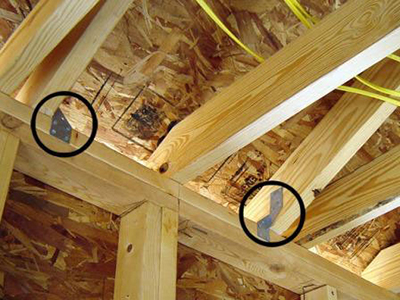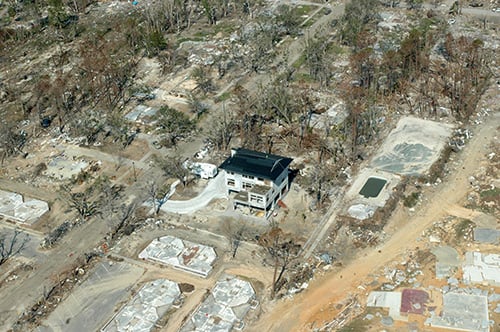
Improving Wind Mitigation Incentives
Aug 21, 2013
Editor's Note: Wind mitigation incentives vary by state, as do their effectiveness. This article describes the challenges in developing successful wind mitigation discount schemes and explores how AIR can help.
Engineers widely agree that a residential building acts as a system, where the weakest link often determines whether the building stands or fails as a unit. This principle has significant implications when quantifying the benefits of fortifying and retrofitting building features against high winds. Catastrophe models are the right tools for this job, but they need to be used in the proper context and with best modeling practices in mind. This article explores the challenges in incenting mitigation and how AIR's hurricane model can be used to formulate a comprehensive approach that encompasses engineering, insurance, and public policy considerations.
Improving Survivability
To ensure integrity of the building envelope, all parts of a house must be properly connected. Roof, walls, and foundation should be anchored together to create a continuous load path that distributes and attenuates the forces exerted by the wind rather than focus them, destructively, on the structure's weak points. Windows and doors, vulnerable elements of a building's envelope, should be secured to prevent wind-borne debris from breaching the structure.
The best time to improve the storm-worthiness of homes is during design and construction. As structural performance has become better understood, building codes and their enforcement have improved significantly over time. The superior hurricane performance of newer construction demonstrates that well designed and properly constructed buildings can withstand all but the very strongest winds.

Yet the majority of homes in high-risk areas are of older construction, built at a time when building codes were generally less effective and less rigorously enforced. These structures are much more vulnerable and have performed poorly in many recent events.
Although options are limited once homes have been completed, some retrofit strategies are effective in strengthening older properties (see callout box). These measures "harden" the housing stock and work to every stakeholder's advantage; they lessen property and community damage, enable better use of emergency management and disaster recovery resources, lower insurance losses, reduce availability and affordability problems in the insurance market, and keep homeowners safe.
The cost of retrofitting an older property, however, can be significant, so various incentives have been put in place to encourage voluntary mitigation. However, a disappointingly low amount of remedial work has actually been done. The out-of-pocket cost to the consumer and the inability of this cost to be "paid back" over an attractive time period are some of the reasons for slow progress.

State Insurance Incentive Programs—A Mixed Bag
Property insurers, as a routine matter of maintaining actuarially sound and lawful rates, require lower premiums from properties classified as less vulnerable. Often, the incentive mechanism is a mitigation credit to annual premiums, applied against a base rate for a similarly located, but unreinforced, home.
In general, the payback period associated with a consumer's investment in mitigation cannot be shortened to just a few years solely through the benefit of actuarially sound, reduced insurance premiums. To improve the cost-benefit prospect, states have taken a variety of approaches, some leaning heavily on insurance incentives, others more heavily on financing assistance and grant programs that may shorten the payback period.
Regulators in most coastal states have encouraged the use of mitigation discounts, but how the discounts are regulated varies by state (Table 1), as does their degree of success.
| Alabama | Mandates that insurers provide the Department of Insurance with actuarially justified rating plans containing appropriate discounts. These are available to any owner who builds or retrofits insurable property in any county contiguous to the Gulf of Mexico and Mobile Bay, to mitigate loss due to hurricane or other catastrophic windstorm events. |
| Florida | Requires insurance companies to offer discounts, promulgated by the Office of Insurance Regulation, for features demonstrated to reduce windstorm losses. These discounts apply only to the windstorm (including non-hurricane wind) portion of policies. |
| Louisiana | Mandates that insurers provide a premium discount to homeowners who build or retrofit a structure to comply with the State Uniform Construction Code using construction techniques that reduce the amount of damage from a windstorm or hurricane. Discounts vary by company. |
| Maryland | Requires insurers to offer at least one actuarially justified premium discount to policyholders who submit proof of improvements made to mitigate loss from a hurricane or other storm. Premium discounts can total 45% of the original policy's premium. |
| Mississippi | Mandates that insurers give wind mitigation credits to qualified new and existing homeowners in Harrison, Hancock, Jackson, Stone, and Pearl River counties. Discounts vary by insurer and can reach 30% of total premium for the Mississippi Windstorm Underwriting Association (wind pool). |
| New York | Homeowners can qualify for credits by installing storm shutters or hurricane-resistant laminated glass meeting specified standards for withstanding wind pressure and the impact of wind-driven debris. |
| South Carolina | Insurers are required to file rating plans for properties in the coastal and seacoast areas, with mitigation discounts and credits or surcharges and debits for rating factors, including the use of storm shutters, roof tie-downs, having flood insurance, and elevation. Discounts vary by insurer. |
| Texas | The state's hurricane insurance pool, the Texas Windstorm Insurance Association, offers premium discounts of 19% to 33% for building code compliance. Windstorm insurance discounts are available for qualifying new homes or for existing structures on which exterior openings have been retrofitted with windborne debris-resistant products. |
Some states have mandated that insurers provide mitigation credits, while leaving the determination of the credit scheme and its integration with the existing actuarial rating plan up to the insurer, with rate filings subject to regulatory review. Mississippi, Louisiana, South Carolina, and Maryland are examples. Some of these states, like Mississippi, have encouraged their state "wind pools" or coastal property residual markets to be the trend-setters. Mississippi's wind pool structures its mitigation incentives using a "package" approach, where combinations of retrofits earn successively larger premium discounts as the package becomes more expansive. There is growing realization among industry thinkers that this approach eases the decisions for consumers and simplifies the public policy associated with insurance incentives.
In contrast, Florida has the strictest legislation, mandating that insurance companies offer "actuarially reasonable discounts, credits, or other rate differentials" for the windstorm (including non-hurricane wind) portion of their policy premiums. Since 2003, Florida's Office of Insurance Regulation (OIR) has essentially required standardized discounts based on a 2002 mitigation study. This matrix of premium discounts and feature combinations is known as Form 1655—an excerpt of which is shown in Table 2. These discounts are provided "for fixtures or construction techniques, including minimum provisions of the Florida Building Code which have been demonstrated to reduce windstorm loss."
| Description of Feature | Estimated Discount | |
|---|---|---|
| Roof Covering (i.e., shingles or tiles) | ||
| Meets the Florida Building Code | 11% | |
| Reinforced Concrete Roof Deck (if this feature is installed, home most likely will not qualify for any other discount.) | 82% | |
| Roof-to-Wall Connection | ||
| "Toe Nails"—3" nails driven at an angle through rafter and into top roof | 0% | |
| Clips—pieces of metal nailed into the side of the rafter/truss and into the side of the top plate or wall stud. | 35% | |
| Single Wraps—a single strap attached to side and/or bottom of top plate and nailed to the rafter/truss. | 35% | |
| Double Wraps—straps attached to side and/or bottom of top plate and nailed to the rafter/truss. | 35% | |
| Shutters | ||
| None. | 0% | |
| Intermediate Type—strong enough to meet half the old Miami-Dade building code standards. | 35% | |
| Hurricane Protection Type—strong enough to meet the current Miami-Dade building code standards. | 44% | |
The initial benchmarks may have been appropriate when the new law was implemented, but the one-size-fits-all approach is now seen by many to be a significant drawback in the marketplace. A sudden doubling of the mandated credits in 2007, expansions in their scope over time to non-hurricane wind premium, and their failure to reflect fixed expenses not reduced by mitigation, have all contributed to a poor match between gross premiums and reinsurance costs for some mitigated homes, resulting in underwriting losses. This has created, for some insurers, the perverse incentive to seek out unreinforced properties.
Recently, a judge invalidated part of Form 1655 in response to a lawsuit by a maker of retrofits that improve the wind resistance of garage doors because insurance regulators had focused on discounts for mitigation against only wind-blown debris. Although an insurer has always had the option to submit a "detailed alternate study" with a different set of mitigation credits, until recently few companies have had success in doing so.
Although the ruling has been stayed on appeal by the OIR, the case may catalyze a discussion with regulators about the future of Florida's mitigation approach. A more objective, risk-based method would require a study of customized mitigation credits using a state-of-the-art catastrophe model and specific details about the expense structure of the insurer. AIR is deeply experienced in conducting wind loss mitigation studies for insurance incentives, having performed projects for regulators, emergency managers, and insurers in a variety of coastal states.
How AIR Can Help
The AIR U.S. hurricane model can help insurers develop a customized mitigation credit scheme suitable for their unique risk profile. An actuarially sound approach favors the use of a "notional" dataset of hypothetical properties spread around the region of interest, a detailed understanding of the many individual risk features, and in-depth knowledge of how to properly analyze these features within the software. AIR's data format is public and transparent, but the mapping of feature descriptions can be complex. AIR's consultants can help an insurer get it right the first time.
As wind pools are often the test cases for mitigation programs, AIR's deep experience with residual market dynamics and relationships with pool managers helps us in developing proper benchmarks for premium credits and in providing guidance regarding the applicability of such benchmarks to the voluntary market.
Regulators, emergency managers, and other public stakeholders can use AIR's products and services as well to study the costs and benefits of grant and loan programs to shorten the payback period and to prioritize the mitigation packages that offer the greatest benefit to disaster recovery costs and community safety. AIR's expertise in construction costs and our relationships with our sister companies that are the dominant players in this field uniquely position us to recommend the correct policy prescriptions for success in rolling out mitigation incentives.
Ultimately, consumers benefit from better information about which measures are more cost-effective, leading to improved decision-making on how to spend a limited retrofit budget. Good information also allows homeowners to work opportunistically, for example upgrading roof components when shingles next need replacing, or adding impact-resistant windows during remodeling.
Conclusion
As the coastal exposure of the U.S. grows inexorably, the need to mitigate hurricane losses for individual consumers and whole communities becomes all the more imperative. Past hurricane experience has shown which mitigation features work to reduce losses, while states have served as laboratories for insurance and retrofitting incentives over the past decade. AIR can take the lessons learned in all of these arenas and put them to use. By partnering with insurers and their external stakeholders, AIR can help quantify and improve wind loss mitigation efforts.
 By: John Rollins, FCAS, MAAA
By: John Rollins, FCAS, MAAA By: Jonathan Kinghorn
By: Jonathan Kinghorn